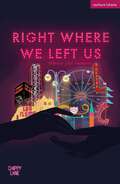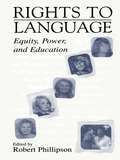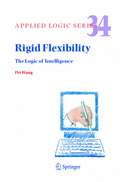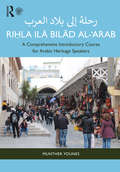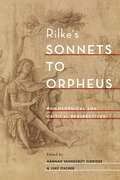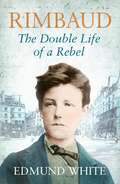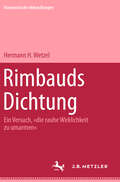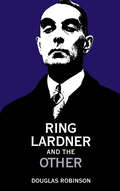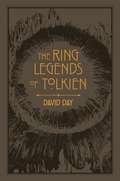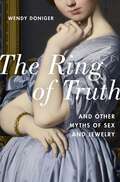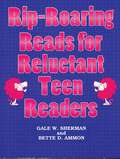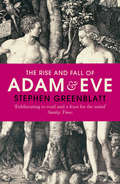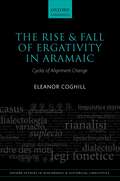- Table View
- List View
right where we left us (Modern Plays)
by Rebecca Jade HammondI thought I would be grafting and working on it.Pursuing it until I breathed my last breath.My ambition and drive was that concrete.But ambition will…Ambition will kill you.The spark is instant. Miles away from home they find each other. They were going to make it big, together.Fast forward years later, a world reset and changed forever they return to where they left it. One an award-winning writer, the other adopting a child and putting faith in crystals. The spark is still there, electric and dangerous. But how do you heal once you've been burned? Right Where We Left Us is a lyrical and witty three-hander and a heartfelt examination of what happens instead of “happy ever after”.A new Welsh play produced by Welsh theatre makers Chippy Lane Productions, this edition was published to coincide with the world premiere at the Chapter Arts Centre, in September 2022.
right where we left us (Modern Plays)
by Rebecca Jade HammondI thought I would be grafting and working on it.Pursuing it until I breathed my last breath.My ambition and drive was that concrete.But ambition will…Ambition will kill you.The spark is instant. Miles away from home they find each other. They were going to make it big, together.Fast forward years later, a world reset and changed forever they return to where they left it. One an award-winning writer, the other adopting a child and putting faith in crystals. The spark is still there, electric and dangerous. But how do you heal once you've been burned? Right Where We Left Us is a lyrical and witty three-hander and a heartfelt examination of what happens instead of “happy ever after”.A new Welsh play produced by Welsh theatre makers Chippy Lane Productions, this edition was published to coincide with the world premiere at the Chapter Arts Centre, in September 2022.
The Right Word: A Writer's Toolkit of Grammar, Vocabulary and Literary Terms (Writers' and Artists')
by Bloomsbury PublishingThis three-in-one guide is the perfect addition to any professional or amateur writer's bookshelf. Aimed at those who use language in their day-to-day lives, it is divided into three parts. The Grammar Guide provides clear, comprehensive guidance on sentence structure, parts of speech and punctuation; the Vocabulary Builder helps you choose the right word by listing commonly confused, misused and cliched words; the dictionary of Literary Terms provides concise definitions of linguistic forms. The budding writer can use this guide to quickly enhance their style and improve their word power. The rules and advice provided are accompanied by usage examples throughout.
The Right Word: A Writer's Toolkit of Grammar, Vocabulary and Literary Terms (Writers' and Artists')
by Bloomsbury PublishingThis three-in-one guide is the perfect addition to any professional or amateur writer's bookshelf. Aimed at those who use language in their day-to-day lives, it is divided into three parts. The Grammar Guide provides clear, comprehensive guidance on sentence structure, parts of speech and punctuation; the Vocabulary Builder helps you choose the right word by listing commonly confused, misused and cliched words; the dictionary of Literary Terms provides concise definitions of linguistic forms. The budding writer can use this guide to quickly enhance their style and improve their word power. The rules and advice provided are accompanied by usage examples throughout.
Rights to Language: Equity, Power, and Education
by Robert PhillipsonRights to Language: Equity, Power, and Education brings together cutting-edge scholarship in language, education, and society from all parts of the world. Celebrating the 60th birthday of Tove Skutnabb-Kangas, it is inspired by her work in minority, indigenous, and immigrant education; multilingualism; linguistic human rights; and global language and power issues. Rights to Language situates issues of minorities and bilingual education in broader perspectives of human rights, power, and the ecology of language. The rich mix of papers serves to underline that the issues are comparable worldwide, that many disparate topics can cross-fertilize each other, and that our understanding of the issues can benefit from coverage that is global, reflective, and committed. A Web site with additional resource materials to this book can be found on http://www.cbs.dk/staff/phillipson/
Rights to Language: Equity, Power, and Education
by Robert PhillipsonRights to Language: Equity, Power, and Education brings together cutting-edge scholarship in language, education, and society from all parts of the world. Celebrating the 60th birthday of Tove Skutnabb-Kangas, it is inspired by her work in minority, indigenous, and immigrant education; multilingualism; linguistic human rights; and global language and power issues. Rights to Language situates issues of minorities and bilingual education in broader perspectives of human rights, power, and the ecology of language. The rich mix of papers serves to underline that the issues are comparable worldwide, that many disparate topics can cross-fertilize each other, and that our understanding of the issues can benefit from coverage that is global, reflective, and committed. A Web site with additional resource materials to this book can be found on http://www.cbs.dk/staff/phillipson/
Rigid Flexibility: The Logic of Intelligence (Applied Logic Series #34)
by Pei WangThis book is the most comprehensive description of the decades-long Non-Axiomatic Reasoning System (NARS) project, including its philosophical foundation, methodological consideration, conceptual design details, implications in the related fields, and its similarities and differences to many related works in cognitive science. While most current works in Artificial Intelligence (AI) focus on individual aspects of intelligence and cognition, NARS is designed and developed to attack the AI problem as a whole.
Riḥla ilā Bilād al-‘Arab رحلة إلى بلاد العرب: A Comprehensive Introductory Course for Arabic Heritage Speakers
by Munther YounesRiḥla ilā Bilād al-‘Arab starts with the Arabic alphabet and gradually and systematically builds the reading and writing skills and mastery of Fuṣḥā grammar. As students develop their reading, writing, and grammar skills, they will be learning about Arab history, society, and culture. This book contextualizes Arabic grammar teaching with sufficient and relevant drills and exercises. Added personal and cultural interest is given by the diary of Amal, an American student of Arab descent, who travels to Jordan and Palestine. This textbook includes maps, illustrations, and photographs and is accompanied by audio on the companion website that can be viewed here: www.routledge.com/cw/younes . The book is designed for Arabic heritage students—students who can understand and speak an Arabic dialect (Egyptian, Iraqi, Moroccan, etc.) but are unfamiliar with Modern Standard Arabic, known as Fuṣḥā.
Riḥla ilā Bilād al-‘Arab رحلة إلى بلاد العرب: A Comprehensive Introductory Course for Arabic Heritage Speakers
by Munther YounesRiḥla ilā Bilād al-‘Arab starts with the Arabic alphabet and gradually and systematically builds the reading and writing skills and mastery of Fuṣḥā grammar. As students develop their reading, writing, and grammar skills, they will be learning about Arab history, society, and culture. This book contextualizes Arabic grammar teaching with sufficient and relevant drills and exercises. Added personal and cultural interest is given by the diary of Amal, an American student of Arab descent, who travels to Jordan and Palestine. This textbook includes maps, illustrations, and photographs and is accompanied by audio on the companion website that can be viewed here: www.routledge.com/cw/younes . The book is designed for Arabic heritage students—students who can understand and speak an Arabic dialect (Egyptian, Iraqi, Moroccan, etc.) but are unfamiliar with Modern Standard Arabic, known as Fuṣḥā.
Rilke: The Life of the Work
by Charlie LouthThe life of Rilke's work is in its words, and this book attends closely to the development of that life as it unfolds over Rilke's career. What is a poem, and how does it act upon us when we read? This is a question of the greatest interest to Rilke, who addresses it in several poems and for whom the experience of reading affords an interaction with the world, a recalibration of our ways of attending to it, which set it apart from other kinds of experience. Rilke's work is often approached in periods—he is the author of the Neue Gedichte, or of Malte, or of the Duino Elegies, or of the Sonette an Orpheus—as if the different phases of his work had little to do with one another, but in fact it is a concentrated and evolving exploration of the possibilities of poetic language, a working of the life of words into precise and exacting forms in dialogue with the texture of the world. This book traces that trajectory in a series of close readings that do not neglect the lesser-known, uncollected poems and the poems in French, as well as Rilke's activity as a translator of Michelangelo, Shakespeare, Barrett Browning, Mallarmé, and Valéry, among many others. These encounters were part of Rilke's engagement with the world, his way of extending the reach of his language to get it ever closer to the ungraspable movements, the risk and promise, of life itself. One of his best-known poems ends with the words 'You must change your life', an injunction that can be seen to animate the whole of his work.
Rilke: The Life of the Work
by Charlie LouthThe life of Rilke's work is in its words, and this book attends closely to the development of that life as it unfolds over Rilke's career. What is a poem, and how does it act upon us when we read? This is a question of the greatest interest to Rilke, who addresses it in several poems and for whom the experience of reading affords an interaction with the world, a recalibration of our ways of attending to it, which set it apart from other kinds of experience. Rilke's work is often approached in periods—he is the author of the Neue Gedichte, or of Malte, or of the Duino Elegies, or of the Sonette an Orpheus—as if the different phases of his work had little to do with one another, but in fact it is a concentrated and evolving exploration of the possibilities of poetic language, a working of the life of words into precise and exacting forms in dialogue with the texture of the world. This book traces that trajectory in a series of close readings that do not neglect the lesser-known, uncollected poems and the poems in French, as well as Rilke's activity as a translator of Michelangelo, Shakespeare, Barrett Browning, Mallarmé, and Valéry, among many others. These encounters were part of Rilke's engagement with the world, his way of extending the reach of his language to get it ever closer to the ungraspable movements, the risk and promise, of life itself. One of his best-known poems ends with the words 'You must change your life', an injunction that can be seen to animate the whole of his work.
Rilke-Handbuch: Leben – Werk – Wirkung
by Dorothea LauterbachRilke hat "das deutsche Gedicht zum ersten Mal vollkommen gemacht", urteilte Robert Musil. Grund genug, Leben und Werk in einem eigenen Handbuch unter die Lupe zu nehmen. Von bleibender Aktualität, skeptisch gegenüber allen einseitig rationalen, psychologisch-soziologischen Welterklärungen entwirft Rilke ein Menschenbild mit rein poetischen Mitteln. Rilkes Biografie, seine Beziehungen z.B. zur russischen Literatur und den Dichterinnen Marina Zwetajewa und Anna Achmatova, zur Psychoanalyse und zu anderen Künsten erschließen das Schaffen in allen Schattierungen.
Rilke’s Hands: An Essay on Gentleness (Routledge Focus on Literature)
by Harold SchweizerThis is a book of meditative reading. Each of the sixty-one aphoristic entries aims to interpret Rilke’s poetry as a musician might play Debussy’s Clair de lune, to transpose into the key of language the song, the melody, and the refrain of Rilke’s gentle disposition: his recognition of the transience of things; his acknowledgment of the vulnerability and fragility of people, animals, and flowers; his empathy toward those who suffer. The cut flowers gently laid out on the garden table "recovering from their death already begun" in one of theSonnets to Orpheus form a thread now visible now faint through most of this book. And because of the flowers, the concept of gentleness forms another thread, and because of gentleness, hands—agents of gentleness throughout Rilke’s poetry—enfold these pages. The German word leise (gentle, tender, quiet) weaves the first thread; the second is woven by flowers, then by girls’ hands, then by angels, the beloved, the poor, the dying and the dead, animals, birds, dogs, fountains, things, vanishings. The purpose of this essay is to experience and to examine gentleness, how it shapes and pervades Rilke’s work, how his poetry might gently inspire us to become more gentle people.
Rilke’s Hands: An Essay on Gentleness (Routledge Focus on Literature)
by Harold SchweizerThis is a book of meditative reading. Each of the sixty-one aphoristic entries aims to interpret Rilke’s poetry as a musician might play Debussy’s Clair de lune, to transpose into the key of language the song, the melody, and the refrain of Rilke’s gentle disposition: his recognition of the transience of things; his acknowledgment of the vulnerability and fragility of people, animals, and flowers; his empathy toward those who suffer. The cut flowers gently laid out on the garden table "recovering from their death already begun" in one of theSonnets to Orpheus form a thread now visible now faint through most of this book. And because of the flowers, the concept of gentleness forms another thread, and because of gentleness, hands—agents of gentleness throughout Rilke’s poetry—enfold these pages. The German word leise (gentle, tender, quiet) weaves the first thread; the second is woven by flowers, then by girls’ hands, then by angels, the beloved, the poor, the dying and the dead, animals, birds, dogs, fountains, things, vanishings. The purpose of this essay is to experience and to examine gentleness, how it shapes and pervades Rilke’s work, how his poetry might gently inspire us to become more gentle people.
Rilke's Sonnets to Orpheus: Philosophical and Critical Perspectives
Written in three weeks of creative inspiration, Rainer Maria Rilke's Sonnets to Orpheus (1923) is well known for its enigmatic power and lyrical intensity. The essays in this volume forge a new path in illuminating the philosophical significance of this late masterpiece. Contributions illustrate the unique character and importance of the Sonnets, their philosophical import, as well as their significant connections to the Duino Elegies (completed in the same period). The volume features eight essays by philosophers, literary critics, and Rilke scholars, which approach a number of the central themes and motifs of the Sonnets as well as the significance of their formal and technical qualities. An introductory essay (co-authored by the editors) situates the book in the context of philosophical poetics, the reception of Rilke as a philosophical poet, and the place of the Sonnets in Rilke's oeuvre. Above all, this volume's premise is that an interdisciplinary approach to poetry and, more specifically, to Rilke's Sonnets, can facilitate crucial insights with the potential to expand the horizons of philosophy and criticism. Essays elucidate the relevance of the Sonnets to such wide-ranging topics as phenomenology and existentialism, hermeneutics and philosophy of language, philosophy of mythology, metaphysics, Modernist aesthetics, feminism, ecocriticism, animal ethics, and the philosophy of technology.
RILKE'S SONNETS TO ORPHEUS OXPL C: Philosophical and Critical Perspectives
by Hannah Vandegrift Eldridge and Luke FischerWritten in three weeks of creative inspiration, Rainer Maria Rilke's Sonnets to Orpheus (1923) is well known for its enigmatic power and lyrical intensity. The essays in this volume forge a new path in illuminating the philosophical significance of this late masterpiece. Contributions illustrate the unique character and importance of the Sonnets, their philosophical import, as well as their significant connections to the Duino Elegies (completed in the same period). The volume features eight essays by philosophers, literary critics, and Rilke scholars, which approach a number of the central themes and motifs of the Sonnets as well as the significance of their formal and technical qualities. An introductory essay (co-authored by the editors) situates the book in the context of philosophical poetics, the reception of Rilke as a philosophical poet, and the place of the Sonnets in Rilke's oeuvre. Above all, this volume's premise is that an interdisciplinary approach to poetry and, more specifically, to Rilke's Sonnets, can facilitate crucial insights with the potential to expand the horizons of philosophy and criticism. Essays elucidate the relevance of the Sonnets to such wide-ranging topics as phenomenology and existentialism, hermeneutics and philosophy of language, philosophy of mythology, metaphysics, Modernist aesthetics, feminism, ecocriticism, animal ethics, and the philosophy of technology.
Rimbaud: The Double Life of a Rebel
by Edmund WhitePoet and prodigy Arthur Rimbaud (1854-1891) died young but his extraordinary poetry continues to influence and inspire - fans include Dylan, Jim Morrison, Patti Smith. His long poem Un Saison en Enferand his collection Illuminations are central to the modern canon. Having sworn off writing at the age of twenty-one, Rimbaud drifted around the world from scheme to scheme, ultimately dying from an infection contracted while gun-running in Africa. He was thirty-seven. Distinguished biographer, novelist, and memoirist Edmund White brilliantly explores the young poet's relationships with his family and his teachers, as well as his notorious affair with the older and more established poet Paul Verlaine. He reveals the longing for a utopian life of the future and the sexual taboos that haunt Rimbaud's works, offering incisive interpretations of the poems and his own artful translations to bring us closer to this great and mercurial poet.
Ring Lardner and the Other
by Douglas RobinsonRing Lardner and the Other is actually two books, mutually embedded. The first is about Ring Lardner: a long reading of a single Lardner short story, "Who Dealt?", a briefer look at his life and work, and an exploration of his reception. The second is about the "Other," in an expanded Lacanian sense: the speaking of various unconscious voices (mother and father and child, culture and anarchy, majority and minority) through literary characters and their authors and readers. The Lardner book explores the contradictions of Lardner's patriarchal masculinity--how such a dour, sexist alcoholic who hated humor and bad grammar could have created such a rich body of minoritarian writing, steeped in the emergent voices of women and the lower middle class--and the social functions served by Lardner's writing in twentieth-century America. The other book exfoliates Lacan's germinal concept of the Other by interweaving it with a series of theoretical formulations by Bateson, Deleuze and Guattari, and others. Robinson's book is an important reappraisal of a critically neglected American writer of the teens and twenties. The book includes an essay by Ellen Gardiner.
The Ring Legends of Tolkien: An Illustrated Exploration of Rings in Tolkien's World, and the Sources that Inspired his Work from Myth, Literature and History
by David DayTolkien's One Ring, at the centre of one of the greatest fantasy tales ever told, is an undeniably iconic and powerful symbol in literature. Tracing centuries of ancient folklore, The Ring Legends of Tolkien is a deep and highly informed investigation into the inspiration behind Tolkien's epic fantasy world, exploring the origins of the One Ring, as well as the extraordinary myths and legends that inspired Tolkien's works.This work is unofficial and is not authorized by the Tolkien Estate or HarperCollins Publishers.
The Ring of Truth: And Other Myths of Sex and Jewelry
by Wendy DonigerWhy are sex and jewelry, particularly rings, so often connected? Why do rings continually appear in stories about marriage and adultery, love and betrayal, loss and recovery, identity and masquerade? What is the mythology that makes finger rings symbols of true (or, as the case may be, untrue) love? The cross-cultural distribution of the mythology of sexual rings is impressive--from ancient India and Greece through the Arab world to Shakespeare, Marie Antoinette, Wagner, nineteenth-century novels, Hollywood, and the De Beers advertising campaign that gave us the expression, "A Diamond is Forever." Each chapter of The Ring of Truth, like a charm on a charm bracelet, considers a different constellation of stories: stories about rings lost and found in fish; forgetful husbands and clever wives; treacherous royal necklaces; fake jewelry and real women; modern women's revolt against the hegemony of jewelry; and the clash between common sense and conventional narratives about rings. Herein lie signet rings, betrothal rings, and magic rings of invisibility or memory. The stories are linked by a common set of meanings, such as love symbolized by the circular and unbroken shape of the ring: infinite, constant, eternal--a meaning that the stories often prove tragically false. While most of the rings in the stories originally belonged to men, or were given to women by men, Wendy Doniger shows that it is the women who are important in these stories, as they are the ones who put the jewelry to work in the plots.
The Ring of Truth: And Other Myths of Sex and Jewelry
by Wendy DonigerWhy are sex and jewelry, particularly rings, so often connected? Why do rings continually appear in stories about marriage and adultery, love and betrayal, loss and recovery, identity and masquerade? What is the mythology that makes finger rings symbols of true (or, as the case may be, untrue) love? The cross-cultural distribution of the mythology of sexual rings is impressive--from ancient India and Greece through the Arab world to Shakespeare, Marie Antoinette, Wagner, nineteenth-century novels, Hollywood, and the De Beers advertising campaign that gave us the expression, "A Diamond is Forever." Each chapter of The Ring of Truth, like a charm on a charm bracelet, considers a different constellation of stories: stories about rings lost and found in fish; forgetful husbands and clever wives; treacherous royal necklaces; fake jewelry and real women; modern women's revolt against the hegemony of jewelry; and the clash between common sense and conventional narratives about rings. Herein lie signet rings, betrothal rings, and magic rings of invisibility or memory. The stories are linked by a common set of meanings, such as love symbolized by the circular and unbroken shape of the ring: infinite, constant, eternal--a meaning that the stories often prove tragically false. While most of the rings in the stories originally belonged to men, or were given to women by men, Wendy Doniger shows that it is the women who are important in these stories, as they are the ones who put the jewelry to work in the plots.
Rip-Roaring Reads for Reluctant Teen Readers (Non-ser.)
by Gale W. Sherman Bette D. AmmonSelected for their high interest, appealing formats, appropriate reading levels, outstanding writing, and popularity, these contemporary, spellbinding titles (20 for grades 5-8 and 20 for grades 9-12) reflect a variety of genres and themes that will encourage lifelong literacy. Given for each title are genre and themes, review citations, author information, plot summary, reading and interest rankings, booktalks, literature extensions, alternative book report suggestions, and reproducible bookmarks that suggest further reading.
The Rise and Fall of Adam and Eve (Everyman's Library CLASSICS)
by Stephen GreenblattSelected as a book of the year 2017 by The Times and Sunday TimesHumans cannot live without stories. But one story has proved itself the most durable and hauntingly real of all time.The mythic tale of Adam and Eve has shaped conceptions of human origins and destiny for centuries. Stemming from a few verses in an ancient book, it became not just the foundation of three major world faiths, but has evolved through art, philosophy and science to serve as the mirror in which we seem to glimpse the whole, long history of our fears and desires. What is it about Adam and Eve’s story that fascinates us? What does it tell us about how our species lives, dies, works or has sex?In a quest that begins at the dawn of time, Stephen Greenblatt takes us from ancient Babylonia to the forests of east Africa. We meet evolutionary biologists and fossilised ancestors; we grapple with morality and marriage in Milton’s Paradise Lost; and we decide if the Fall is the unvarnished truth or fictional allegory.Ultimately, The Rise and Fall of Adam and Eve allows us a new understanding of ourselves.
The Rise and Fall of Ergativity in Aramaic: Cycles of Alignment Change (Oxford Studies in Diachronic and Historical Linguistics #21)
by Eleanor CoghillThis book traces the changes in argument alignment that have taken place in Aramaic during its 3000-year documented history. Eastern Aramaic dialects first developed tense-conditioned ergative alignment in the perfect, which later developed into a past perfective. However, while some modern dialects preserve a degree of ergative alignment, it has been eroded by movement towards semantic/Split-S alignment and by the use of separate marking for the patient, and some dialects have lost ergative alignment altogether. Thus an entire cycle of alignment change can be traced, something which had previously been considered unlikely. Eleanor Coghill examines evidence from ancient Aramaic texts, recent dialectal documentation, and cross-linguistic parallels to provide an account of the pathways through which these alignment changes took place. She argues that what became the ergative construction was originally limited mostly to verbs with an experiencer role, such as 'see' and 'hear', which could encode the experiencer with a dative. While this dative-experiencer scenario shows some formal similarities with other proposed explanations for alignment change, the data analysed in this book show that it is clearly distinct. The book draws important theoretical conclusions on the development of tense-conditioned alignment cross-linguistically, and provides a valuable basis for further research.
